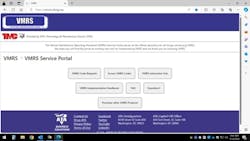Latest VMRS tools for maintenance management success
Fleets are continually looking for ways to save time and money in their maintenance shops. But a mounting feeling of frustration ensues as paperwork piles up, computers get harder to navigate, and technicians receive the wrong repair parts.
To reduce that frustration, shop managers and technicians need to work together, but how? Fortunately, there’s a proven method of cost-control communication—Vehicle Maintenance Reporting Standard (VMRS).
Managed by ATAs’ Technology & Maintenance Council, using VMRS has been shown to improve efficiency in today’s repair facilities. The venerable coding convention offers the means of establishing clear lines of communication in any maintenance facility.
VMRS is much more than numbers; it’s a standard method of recording daily fleet maintenance operations. Technicians save time completing repair orders by cutting down on the time spent writing labor and part descriptions. VMRS also contains the codes needed to help a technician or shop manager complete a repair order in a standard fashion. A better understanding of VMRS will help any technician in the maintenance shop, especially when considering a promotion to shop management.
From its inception, VMRS has been a collaborative effort involving a diverse group of contributors representing the equipment maintenance industry and has been the universal repair language used by many OE manufacturers and fleets. Maintenance software firms also include VMRS in their coding structure, giving fleets the ability to benchmark their repair data. By doing so, fleets can speed up the repair order process and cut down on time spent doing paperwork. In short, VMRS provides that extra advantage in any shop.
New codes are always added to reflect current technologies, such as crash avoidance, lane departure, camera monitoring systems, adaptive speed control, and most recently, codes for electric vehicles.
One other element is about to change. TMC has traditionally distributed the VMRS code updates to licensees with Excel spreadsheets housed in the VMRS Licensee Community on TMC Connect or directly by email. Now, after several months of design and technology decisions, TMC has developed a new method of accessing VMRS with the creation of the Vehicle Maintenance Reporting Standards (VMRS) Services Portal.
The portal offers direct access to the VMRS Implementation Handbook, and users can download a copy, which is important for VMRS training and brushing up on the codes. The Handbook is the official TMC publication of VMRS and contains current information; it’s an invaluable addition for anyone involved in the VMRS process.
Read more: Decoding historical data with diagnostics and VMRS codes
A link to the VMRS Instruction Sets is also found on the portal. VMRS Instruction Sets are composite codes, derived from various Code Keys. The Instruction Sets are numerical sentences, using individual Code Keys as building blocks or words to describe various aspects of equipment specification or labor activities. For example, Instruction Set 1: Engine Type Code is a composite of VMRS Code Keys 34, 35, 6, and 5. Taken together, it describes main and auxiliary engine types.
Licensees will have live access to the Code Keys as well, no longer having to wait to receive quarterly updates. They can also request new codes directly and attach any pertinent information (pdf’s, etc.) needed to fulfill the request. This will take the guesswork out of the code request process, making it much easier for those in need of new codes. Adding new codes is an important aspect of VMRS, as it ensures the codes reflect the latest technologies and keeps VMRS relevant for all involved.
Maintenance labor alerts are a new tool at equipment professionals’ disposal, and a new VMRS Code Key has been created to standardize these telematically delivered alerts. Maintenance labor alerts are generated in advance of a given scheduled activity, serving as notice that the labor in question is due to be performed. With the advent of telematic capabilities onboard commercial vehicles, today these alerts take place digitally with over-the-air updates, but without industry-wide standardization. TMC’s new Code Key 25: Maintenance Labor Alerts provides standardization for such maintenance labor alerts, so there would be commonality among the various manufacturers, providers, software companies, and fleets.
These maintenance labor alerts usually consist of multi-step processes in which multiple tasks and parts are involved. The intent of Code Key 25 is for a single description and code to represent a bundle of activities that typically are associated with a single given maintenance task (such as valve lash adjustments or engine oil, lube, and filter procedures).
Additionally, TMC has created a new Instruction Set consisting of a combination of Code Key 25: Maintenance Labor Alert and existing Code Key 16: Repair Priority Class. Taken together, they provide a means of determining the status of a given suggested maintenance task. Accordingly, Code Key 16 has been expanded to include three new codes used to describe the request that will be indicated after the maintenance alert is received. The three new codes are:
- 4 - Due Soon
- 5 - Past Due
- 6 - Request Performed
VMRS contains the codes that level the playing field for technicians and managers looking for meaningful reports. The codes in VMRS contain the consistency and clarity that fleets need to produce an accurate picture of their maintenance operation. VMRS has the tools that can save any fleet time and money.
The current version of VMRS is version 2.0; find out more about VMRS at 703-838-7928 or send an email to [email protected].
